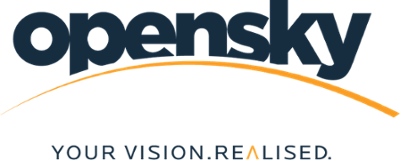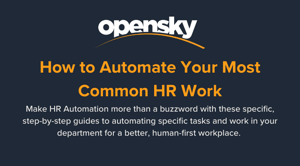How to Eliminate Work You Hate With Microsoft Power Automate
Number crunching. Data entry. Spreadsheets. There are a thousand tasks in our jobs that we all hate. However, these can easily be a thing of the past thanks to the power of automation tools. In this blog, we'll take a look at how you can make the dream of a workday free from repetitive, mind-numbing work a reality.

Repetitive, time-consuming, labour-intensive work that you hate isn't just irritating for you; it actively hampers the speed and agility of your business to do what it does. Now, more than ever, businesses are ripping up their outdated workflows and are looking for systems and practices that save valuable time and resources.
McKinsey found that 66% of organisations have at the very least begun piloting automation of business processes. In the same study, 31% of firms said they have already fully automated at least one function1.
Why are businesses automating processes? What are the benefits of business automation? What tools can facilitate this transition? How can Microsoft Power Platform & Power Automate help?
So, Why are Businesses Automating Processes?
To explore why businesses are turning to automation, let’s first combat a common myth: that automating processes will lead to redundancies and replace people.
The truth is much simpler: automation is no replacement for human innovation and creativity.
Businesses are pursuing automation to optimise employees’ time use, better utilise their resources, and provide a superior customer experience.
Automation and the use of AI lead to a significant reduction in the labour hours spent on mundane and repetitive tasks, such as data entry, financial management, and other such work . PwC refers to a “workforce shift” where employees are freed to better contribute to innovative strategies and growth activities2.
The main gains from automating workflows come when dealing with data. PwC found that automating data analytics using AI extraction and automation can save businesses up to 40% of hours spent on data analysis.
By automating repetitive tasks, you can optimise the way your employees use their time. This improves productivity and thus efficiency. Your staff can spend more time creating value, thus increasing revenue. The expulsion of inefficient legacy techniques - such as paperwork or printing and filing records - will help bring down operating costs.
Finally, automating processes improves your employees’ quality of life and satisfaction. They can spend less time on tedious admin tasks and more on what they’re good at - leading to a happier, more productive workforce.
What is Microsoft Power Automate?
Now we’ve briefly introduced you to the why of business automation, let’s discuss the how. How can businesses implement automation into their existing workflows? The answer is simple: using Microsoft Power Automate.
Microsoft Power Automate is a workflow automation engine that allows your business to streamline repetitive tasks and implement revolutionary paperless processes. It's just one part of the incredibly potent Microsoft Power Platform suite of business tools, which enrich your operations with extensive data connections, business intelligence tools, and automaton potential.
With Power Automate, you can automatically move data between systems, carry out complicated workflows and even control processes natively on your PC with programs such as Excel.
Power Automate uses a wide array of integrations with common business apps and services to provide a simple, drag-and-drop application for creating automated “flows”.
Why use Power Automate?
- Power Automate works with the apps and services you already use, including Dynamics 365, Microsoft 365, Office, Freshbooks, DropBox, Google Drive, and more.
- Workflows can be accessed and carried out from anywhere using a desktop standalone app, a mobile app, a web platform and even integrates with Microsoft Teams
- Using an AI builder, you can optimise workflows quickly - without any technical knowledge needed.
How can Departments use Automation?
Let’s explore Microsoft’s Power Automate in practice. How can certain departments benefit from automating their processes?

Automation in Sales & Marketing
Power Automate can integrate with Customer Relationship Management (CRM) platforms like Salesforce or Dynamics 365 Sales. Indeed, McKinsey states that a third of all sales tasks can be automated.
Examples of automation in Sales & Marketing include:
- Automated workflows for each sales interaction
- Simplify lead generation through lead scoring and profiling using AI
- Automated ingest of marketing data
- Creation of email lists (through integrations with MailChimp)
- Automatically track Twitter mentions and export this data into a spreadsheet (or indeed, add to an email list)
Automation in Finance
Accounting and finance teams are often inundated with tedious workflows. Automation can help save time but also reduce the chance of human error.
Here’s how Power Automate can help finance teams:
- Automation tools can carry multi-stage approvals from start to finish by ensuring files and documents are sent exactly where they need to be for approval.
- Invoicing can be entirely automated where quotes and orders can instantly be invoiced and billed with little to no human input.
- With Power Apps integration, finance departments can create customer portals to make orders, request financial information and access invoices.
- Tools like Power Automate can integrate with accounting platforms like QuickBooks or Freshbooks to handle expenses recording autonomously.
Automation in Human Resources
Human Resources departments play a significant role in any organisation but are often neglected of resources such as staffing, to properly function. Therefore, automating tedious processes can seriously lighten the burden on HR teams.
Automations include:
- Automating timesheet reporting and approval: Timesheets can be generated through Microsoft Calendar entries and can be sent via Team for line managers to approve automatically.
- Improve the speed of onboarding: Keep line managers in the loop of progress, automate onboarding communications and automatically schedule meetings based on milestones.
- Simplify sick leave and absence: One-click sick leave reporting and leave requests that are guided across multi-stage approvals.
Get Started with Automation
When it comes to smart, strategic, and highly effective automation, we at OpenSky always recommend you start by taking a look at the specific tasks that you do very often in a workweek. Here's a few avenues for effective, high-value HR automation that we've identified in the past:
In general, the tasks that are easiest to automate are those that:
- Need completing frequently
- Have a familiar, repetitive workflow
- Take a significant time to complete
- Require multiple people at once to complete
- Fit into wider workflows
Let's consider Human Resources. What work can I automate in HR, and how can I automate HR work? Here are some specific examples:
How to Automate CV Screening & Shortlisting
Programmed robots can crawl applicant CVs, vacancy applications, and other relevenat information to compare the information against a listed of job requirements. This allows you to pre-screen candidates, and automate qualifying/disqualifying notifications to applicants. Further functionality can populate all parts of this process pipeline, with portals that set up calendar events for interviews, share take-home tests, and trigger notifications/share critical documents with all stakeholders.
How to Automate Employee Onboarding, Management, and Exiting
Automation truly shines at these kinds of repetitive, state- or time-triggered events. Automation can activate templates for the onboarding workflow of a new user account, send specific documents to new starters, assign specific credentials, process employee ID's, and more. They can also automatically provide business processes documentation, compliance standards, e-learning & training support via a new employee digital profile, created after they accept the job offer.
Finally, robotic process automation can predefine the exit stage processes by managing the generation of exit documents, revoking system access, completing final payroll, triggering communications to the finances department, and bank and final communications to the individual.
How to Automate Payroll Processing & Internal Purchasing or Costs
Punching numbers and sifting through endless invoices is about as fun as it is fast. That's to say, it isn't. With automation, you can easily streamline this time-consuming, once-a-month (or more) process. RPA can collect & connect data between multiple systems to automatically, verify employees hours worked, log overtime & missing hours, capture changes in taxes, and more – all eliminating the burden of cumbersome payroll processing and freeing up HR staff for other valuable work.
How to Automate Expense Management
There's a reason why bots and automation excel in the financial sector and banks: they're unbeatable when it comes to numbers. RPA and process automation can automatically extract data using a bot to scan receipts and populate data, apply rules to identify the type of submission, automatically generate all necessary letter, bills, invoices, and other such documents, and process or decline the claim. Simple and all with a single click.
How to Automate Compliance
Automated systems can track and store all data points, documentation, licenses, tests, audits, and other such critical organisation documents, with automatic triggers and notifications for signature gathering, renewals, looming expirations, and more. What's more, these systems keep a spotless one-version-of-the-truth record of your company's dealings, making it quick and easy to submit necessary documents whenever inspections, document submission requests, or audits appear.
How to Automate Employee Data Management and Performance Management.
RPA solutions can quicky integrate with existing systems, document repositories, and CRM solutions to make it easier than ever to do all the work that crops up in an average day dealing with employees and staff. With this, you no longer need to manually generate important documents that employees need (for example Proof of Employment letters, offer letters, contracts, and more). Such platforms also pave the way for smart KPI and performance analysis tools, which can make it easy to identify high-value employees to target for retention, or find avenues where improvement is needed.
Get your complimentary 1-on-1 Automation Readiness Assessment
Our decades of experience in developing and implementing high-impact automation software in some of Ireland's largest public and private sector organisations give us an unbeaten ability to assess your organisation's structure and workflows to recommend affordable, achievable, high-return automation that doesn't disrupt your services.
Contact us now for a free 1-on-1 Automation Readiness Assessment of your organisation and workflows, so that you can best understand, approach, and plan your automation project.
Sources
1) https://www.mckinsey.com/business-functions/operations/our-insights/the-imperatives-for-automation-success
2) https://www.pwc.com/us/en/services/tax/reporting-strategy/data-automation.html



